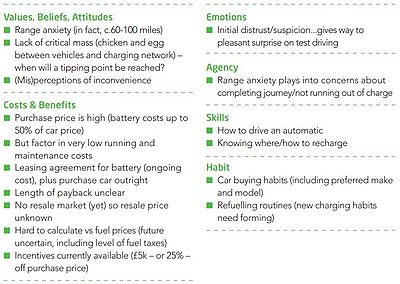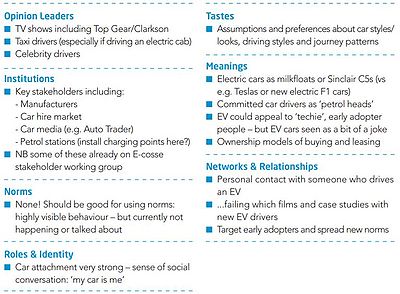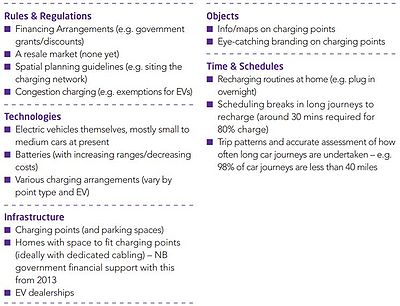ISM Principles of Change
(→Background) |
|||
| Line 14: | Line 14: | ||
== Background == | == Background == | ||
| − | Traditional behavioural models tend to evaluate human behaviour by focusing on the factors separately. However, studies show that human behaviour depends on a combination of several interrelated factors [xx]. The most essential factors are related to the individual, its society, and the surrounding material. A cross-consideration of all three factors increase the chance of success to understand and manipulate human behaviour. The ISM model relies on this concept. | + | Traditional behavioural models tend to evaluate human behaviour by focusing on the factors separately. However, studies show that human behaviour depends on a combination of several interrelated factors [xx]. The most essential factors are related to the individual, its society, and the surrounding material. A cross-consideration of all three factors increase the chance of success to understand and manipulate human behaviour. The ISM model relies on this concept. |
The ISM tool was originally created in 2011 at the University of Manchester to map and influence people's behaviour towards sustainability challenges <ref>''Journal'', Southerton, D., Díaz-Méndez, C., & Warde, A. (2011), Behavioural Change and the Temporal Ordering of Eating Practices. International Journal of Sociology of Agriculture and Food. 19. 19-36. </ref>. In this relation, Andrew Darnton further developed and standardized the ISM classification model in 2013 to cover policy interventions and programme management. The development was based on research and ongoing projects on human behaviour towards sustainability change <ref>''Journal'', Cox, A., Higgins, T., Gloster, R., Foley, B., Darnton, A. (2012), The Impact of Workplace Initiatives on Low Carbon Behaviours. Scottish Government </ref>. Herein, the theoretical contexts were justified in the International Review of Behaviour Change Initiatives <ref>''Journal'', Southerton, D., McMeekin, A., & Evans, D. (2012), International Review of Behaviour Change Initiatives. Scottish Government </ref>. Therefore, the ISM tool is considered to be an all-in-one practical alternative to existing behavioural models by bringing together multiple disciplines based on theory and practice. | The ISM tool was originally created in 2011 at the University of Manchester to map and influence people's behaviour towards sustainability challenges <ref>''Journal'', Southerton, D., Díaz-Méndez, C., & Warde, A. (2011), Behavioural Change and the Temporal Ordering of Eating Practices. International Journal of Sociology of Agriculture and Food. 19. 19-36. </ref>. In this relation, Andrew Darnton further developed and standardized the ISM classification model in 2013 to cover policy interventions and programme management. The development was based on research and ongoing projects on human behaviour towards sustainability change <ref>''Journal'', Cox, A., Higgins, T., Gloster, R., Foley, B., Darnton, A. (2012), The Impact of Workplace Initiatives on Low Carbon Behaviours. Scottish Government </ref>. Herein, the theoretical contexts were justified in the International Review of Behaviour Change Initiatives <ref>''Journal'', Southerton, D., McMeekin, A., & Evans, D. (2012), International Review of Behaviour Change Initiatives. Scottish Government </ref>. Therefore, the ISM tool is considered to be an all-in-one practical alternative to existing behavioural models by bringing together multiple disciplines based on theory and practice. | ||
Revision as of 14:52, 1 March 2021
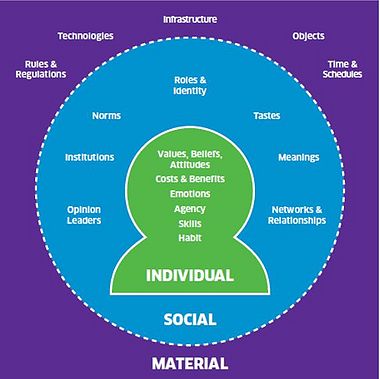
The ISM - Individual, Social, and Material - model is a multi-disciplinary tool to study the human behavior in the aspects of: behavioral economics, social psychology and sociology [1]. It can generate ideas for interventions or manage the behaviour of individuals, teams or stakeholders because it draws insights from all three acknowledged disciplines. Based on theory and evidence, the contexts of the individual, the social, and the material have essential impact on human behaviour. The ISM model facilitates an integrated, whole-system perspective around these three contexts to highlight challenges of individuals, organizations, and partnerships. Through the process, stakeholders aim to develop a shared understanding by identifying their respective roles in bringing about change. Hereby, the model draws insight from multiple disciplines to ease the decision-making of complex problems. The result is a shared ownership of solutions. This is a vital part of programme management to successfully transferring ownership to operations in interrelated projects with the desire of implementing transformational change [2]. The model can also be applied to understand and manage stakeholders in specific projects even though these are often more sensitive to changes. Nonetheless, human behaviour is vital in negotiation and conflict management while misunderstandings of this subject can be fatal [3].
The ISM tool was developed by researcher Andrew Darnton and launched by the Scottish Government in 2013 to evaluate the impact of sustainability challenges in interrelated projects. Since, it has found use for policy makers and practitioners to influence people's behaviors and bring about change [4]. The combination of theoretical and practical aspects of the ISM model is tailored to design or improve programmes, which are utilized in many cases such as waste management, lower carbon emissions, and policy processes. Hence, the applicability of ISM can be used to influence behaviour in the path to implement change through interrelated projects.
Contents |
Background
Traditional behavioural models tend to evaluate human behaviour by focusing on the factors separately. However, studies show that human behaviour depends on a combination of several interrelated factors [xx]. The most essential factors are related to the individual, its society, and the surrounding material. A cross-consideration of all three factors increase the chance of success to understand and manipulate human behaviour. The ISM model relies on this concept.
The ISM tool was originally created in 2011 at the University of Manchester to map and influence people's behaviour towards sustainability challenges [5]. In this relation, Andrew Darnton further developed and standardized the ISM classification model in 2013 to cover policy interventions and programme management. The development was based on research and ongoing projects on human behaviour towards sustainability change [6]. Herein, the theoretical contexts were justified in the International Review of Behaviour Change Initiatives [7]. Therefore, the ISM tool is considered to be an all-in-one practical alternative to existing behavioural models by bringing together multiple disciplines based on theory and practice.
Since its creation, the success of the model has resulted in a technical guide, published by the Scottish Government, and nominated as the tool of choice to implement behavioural change [1]. Moreover, the ISM concept has been mandated all public institutions in Scotland in order to meet certain Carbon budgets. The areas include health care, local authorities, DEFRA, the NUS, the Scottish Natural Heritage, and diverse community groups amongst others.
The Three Aspects
The ISM connects three main theories in behavioural science, which are behavioural economics, social psychology, and sociology, in one single illustration, depicted in the ISM model. The theories are expressed within the context of three symbols: 1) a head (the individual), 2) a circle (the social), and 3) a square (the material). All three contexts contain factors that must be considered to successfully evoke behavioural change as defined below by the creator Andrew Darnton:
The ISM model starts from an understanding of individual behaviour, but sets that within its social and material contexts, illustrating how action on multiple levels by multiple actors is required for inclusive and lasting change.
The factors of each context can both constrain and shape human behaviours. The ISM model contains 18 main factors [1]. It is worth noting that the factors within the ISM classification are not arranged hierarchically in terms of importance. All factors must be considered to fully understand and change human behaviour.
Individual
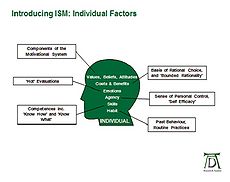
The individual context concerns the factors that individuals have an impact on, herein, the behaviours of individuals that affect decision-making. The behaviour of individuals arise from both personal aspects such as attitudes, values, and skills but also more rational considerations such as cost and benefits. These aspects are elaborated into sense of control, competencies, past behaviour, and rational choices. Each factor affects the project or programme environment in management of individuals, teams, or stakeholders.
Values: (Psychology) The motivational system of the human holds values. The individual judges situations and act upon them based on its value sets. However, the value aspect of individual behaviour has a weak influence on other behaviours. More factors such as attitudes, beliefs, and skills can strengthen the value.
Beliefs: (Psychology) The beliefs of the individual also relate to the motivational system but with a more particular aspect by being in between values and attitudes. The beliefs increase the awareness of the individual's behaviour.
Attitudes: (Psychology) Next to values and beliefs, attitudes are a third main motivational aspect of the individual mindset. Attitudes contribute to human behaviour by reacting to specific objects, activities or people. These often arise from information and experience of the individual.
Costs & Benefits: (Behavioural economics) The basic method of decision-making is based on cost and benefit calculations. The calculations are made by the individual, a social group or relevant stakeholders in terms of what interest they prioritize. However, decisions are influenced by heurestics as people tend to accept the most simple solution even though it might not be the right solution.
Emotions: (Psychology, Behavioural economics) The emotions are a subjective part of decision-making, which must be emphasized by practitioners to convince change. Rational appeals based on factual and logical arguments without emotions can be received as 'cold' evaluations.
Agency: (Psychology, Sociology) Agency is about confidence and self-control, which describes the capacity of individuals to undertake action. High agency is needed to perceive and change behaviour.
Skills: (Psychology, Sociology) The skills are related to needed procedural and factual knowledge to understand and implement a behaviour. The skills overlap with knowledge on cost-benefit calculations and agency.
Habit: (Psychology) A behaviour that is undertaken frequently with little conscious thought is categorized as a habit. Habits are often seen as a barrier to implement behavioural change, hence, awareness of habits must be taken into account in complex change processes.
Social
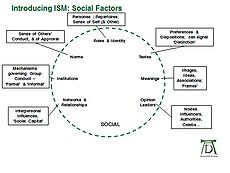
The social context contains factors of society that highly affect the human behaviour. The influences of social factors often stem from a shared understanding amongst groups, which can be a result of social norms, opinions, or networks. However, factors can also be inflicted from institutions to influence the behaviour. Hence, the aspects of social influences must be considered to understand human behaviour. Once the influences and forces are clarified, proper action can be applied to change the behaviour.
Roles & Identity: (Psychology) Roles are socially constructed, while identities are the individuals' sense of who they are. Therefore, roles and identities must be understood and the relevant ones approached to influence certain behaviour changes.
Norms: (Psychology) Individuals classify social norms based on what they observe others doing. Explicit instructions can also lead to norms. Individuals or groups are more likely to accept changes if they are within accepted and relatable norms.
Tastes: (Sociology) Tastes signal preferences of individuals. They are based on shared understandings of desires, which can be used to form behaviours.
Institutions: (Sociology) Institutions can influence or inflict activities in a formal and informal way such as the legal system and family life, respectively. Some institutions can influence tastes and social norms, hence, directly shaping the behaviour of individuals or groups.
Meanings: (Psychology, Sociology) Shared understandings can be expressed by images, ideas, metaphors, and associations. The meanings are labelled within social norms and values, where they set the frame for behaviour.
Networks & Relationships: (Psychology, Behavioural economics) Individuals connect into social networks or relationships to share and develop ideas, norms, and ultimately behaviours. The lack of such relations can be a barrier to change.
Opinion Leaders: (Psychology, Behavioural economics) Some individuals can have strong influence on over others due to their role or identity. Such opinion leaders are capable of shaping social norms. Examples include experts, managers, and celebrities.
Considering the social factors together with the factors of the individual provides a better understand of human behaviour in terms of deliberation.
Material
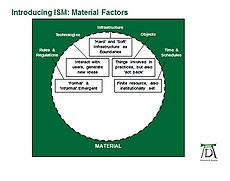
The material context is about the influence of outside factors. These factors are a part of the daily life of individuals, which to a high extent are considered to have a constant impact in society. Such aspects include objects, infrastructure, rules, regulations, and time.
Infrastructure: (All disciplines) Infrastructure can be classified as conditions 'out there in the environment'. This aspect appears in all approaches to behaviour change as it is affected by individual choices.
Technologies: (Sociology) Technologies are sometime contrasted to behaviour as they are often intended to change the behaviour of individuals. In this sense, people interact differently with technology. Misuse or rejection of technologies must also be considered in the understanding of their impact on behaviour.
Objects: (Sociology) Objects, similar to technologies, impact and shape the everyday life of individuals. Objects are often taken for granted and the underlying behaviours the objects evoke are often very relative to the individual.
Rules & Regulations: (Sociology) Institutions set formal and informal rules and regulations that are explicit, which to some extent normalize certain behaviours. Rules and regulations can also be implicit (individuals take off their shoes when entering somebody else's home). Failure of following such rules is left to be judged.
Time & Schedules: (Sociology) Time is a well-defined, finite resource that must be scheduled accordingly. Individuals allocate their time systematically to fit their respective activities. A change in an individual's time have the potential to affect the related activities and ultimately the behaviour.
All 18 factors play a role in the approach to social change, which are based on three main disciplines in human behaviour. The addition of material impact on individuals and their societies connects important driving forces for behaviour changes in the everyday life of people. Even though the factors are equally present in the ISM model, they are meant as guidelines to understand behaviours. Moreover, some factors may be more relevant for certain individuals as they are affected differently by each factor. A proper understanding of such relations allows policy makers and practicioners to fit or manipulate behaviour changes in a certain way.
Theoretical background
The justification of the ISM concept relies on the most prominent practical disciplines of human behaviour; behavioural economics, social psychology, and sociology. The individual, social, and material contexts draw influences from all three disciplines combined, which keeps the ISM model relevant in any society at any time. In management of individuals or groups such cross-combinations are of high importance to emphasize with people's interests. Studies show that the majority of failed project and programme management tend to lack in one or more disciplines when communicating with stakeholders [xx]. This can be directly interpreted as a process of unexpected behaviours between the manager and the team members as well as stakeholders.
Behavioural economics [5]
The study of behavioural economics analyzes the decision-making of a centralized individual or groups. The concerned effects of emotional, cultural, and social factors are considered. Within this aspect, the traditional representation covers a rational individual who operates to maximize its own interest. The decision-makings of the individual are based on rational factors such as cost-benefit calculations while it also consider heuristics, which describes the shortcuts in reaching decisions. While the former is typical for a rational individual, the latter tends to decrease the success of decision-making.
In general, managers must be aware of these different types of behaviours to successfully manage individuals, teams, or stakeholders in a desired direction. Especially in interrelated projects, like programmes, it is essential to understand the behavioural economics of the relevant stakeholders when introducing change in complex projects. To ease the handling of such processes, the Nudge theory can be applied to propose positive reinforcement.
Social psychology [6]
In social psychology, behaviours are understood as choices of the individual. However, the individual is highly impacted by social norms, roles, and relations, hence, it operates as a part of (or against) the collective. Within the collective exists attitudes, opinions, and identities that are affected by emotions as much as cold calculus and peer-pressure. These factors must be considered within the social psychology aspect to impact behaviours, and ultimately change.
The knowledge of social psychology is already employed in areas of marketing and management. The former utilizes this aspect of human behaviour to target desired clients, while the latter makes more influential leaders by including the interest of the majority [8].
The combination of behavioural economics and social psychology can address challenges in a convincing manner to a large audience. However, a practical aspect must be included as well to implement a lasting change in behaviour. Such practices can be found in sociology.
Sociology [7]
The theories of sociology cover many aspects of human behaviour. In contrast to social psychology, this aspect in the ISM concept is of a more practical manner. It is the study of 'doing and saying', where behaviours are explained as patterns of action. This discipline assumes that people recognise behaviours as they are shared and socialized amongst groups. Hence, reactions of human behaviour evoked by change can be foreseen, which ultimately allows manipulation of behaviour. The conceptual connection of the dots in the ISM model relies on this exact aspect.
This aspect is often missing in management of teams or stakeholders. The consequences are dissatisfied stakeholders with non-aligned views and miscommunication. Such factors have an impact on the so-called ''triangle'' in project management that is the time, cost, and scope, which in total covers the project quality. Moreover, unexpected behaviours increase the level of uncertainties in projects.
The total combination of the disciplines provides a solid theoretical background of the ISM concept which covers the human behaviour to a large extent as it includes different view of human conduct. Similarly to the factors of ISM, it is worth noting that the theoretical disciplines must all be considered in the study of human behaviour. Relevant literature must be considered to fully understand each discipline and ultimately the theory of human behaviour as the disciplines are only introduced here. Recommendations of further readings include:
Behavioral economics: Nudge, R. H. Thaler (2009).
Social psychology: Influence Science and Practice, R. B. Cialdini (2000).
Sociology: The dynamics of social practice, E. Shove (2012).
ISM in practice
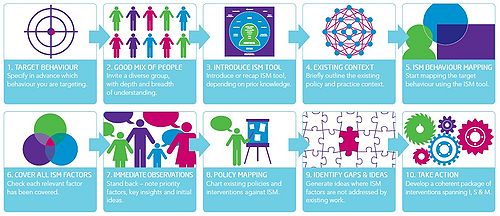
Successful programmes enable transformational changes for or within an organization. By doing so, the programmes coordinate, direct, and evaluate interrelated projects. To ease behaviour changes of individuals, teams or stakeholders, the managers must have background knowledge on human behaviour. If so, the managers can even manipulate with human behaviour. The concept of the ISM tool allows such control, which has already been utilized in many interrelated projects to achieve certain strategic objectives of organizations.
Step-by-step approach
The ISM tool can be used as a planning tool by a project or programme manager to analyze behaviour changes inflicted by projects. However, it is recommended to be used in workshops with a diverse mix of people as many aspects may be covered as suggested by the ISM model. An approach released as a User Guide of by the Scottish Government is given as [9]:
1. Target behaviour: Specify in advance which behaviour you are targeting.
2. Good mix of people: Invite a diverse group, with depth and breadth of understanding.
3. Introduce ISM tool: Introduce or recap ISM tool, depending on prior knowledge.
4. Existing context: Briefly outline the existing policy and practice context.
5. ISM behaviour mapping: Start mapping the target behaviour using the ISM tool.
6. Cover all ISM factors: Check each relevant factor has been covered.
7. Immediate observations: Stand back - note priority factors, key insights and initial ideas.
8. Policy mapping: Chart existing policies and interventions against ISM.
9. Identify gaps and ideas: Generate ideas where ISM factors are not addressed by existing work.
10. Take action: Develop a coherent package of interventions spanning I, S & M.
Beside the exploration of an idea or more, this approach can also be applied to target specific individuals, teams or stakeholders to understand their behaviour in certain aspects.
Examples of use
The ISM concept has been mandated public institutions in Scotland in their approach to meet the Paris Agreement. Hence, it is widely used in the context of sustainability management. The model has been used to analyze behaviour changes and accordingly suggest ideas for sustainable implementations. The areas include lowering carbon emissions, reduce meat consumption, electric vehicles, and recycling.
A worked example on electric vehicles, ordered by the Scottish Government, used the ISM tool to identify factors that must be addressed to implement a behaviour change that supported buying electric vehicles. The approach followed the one stated in the User Guide, which outlined individuals relation to the area of vehicles by considering all 18 factors in the context of the individual (green), the social (blue), and the material (purple) [9]:
Some of the outputs based on the issues and factors raised from the worked example included; Increase of visual impact of charging points, explore alternative charging networks, provide better information - maps and apps of the network of charging points, encourage networks of electrical vehicle drivers, to help calculate payback, cost comparison websites, and think about your mobility. In the managerial aspect, the different stakeholders were considered for each output, where the ISM was used as a re-evaluation tool.
More illustrative examples can be found in the User Guide [9]. The ISM tool is freely available to all.
Limitations
The creator of the ISM model, Andrew Darnton, stated before the birth of the model; There is no one winning model. Although many different theories cover the area of human behaviour, only few practical tools have been developed to mobilise such theories. Even the few practical tools are lacking to some extent as they are often only applicable in specific aspects of behaviour. Hence, the intention of the ISM model is to be an all-in-one model. However, such an approach makes it difficult to go in-depth with the factors, and moreover, to distinguish between the relevant factors. By now, it is clear that the study of human behaviour is huge and most likely impossibe to be expressed by one model. Furthermore, the ISM tool is time and resource consuming as it requires heavy research of all contexts. Nonetheless, the ISM model has proven to be successful on the initial state of programme management challenges and mapping of stakeholder behaviour in such relations.
Further reading
One Solution for Project Success: Project and Change Management in the PMBOK® Guide, Jarocki, T. L. (2014). PMI White Paper. PMI standards provide guidelines for achieving specific project, program, and portfolio management results. They outline characteristics of PM approaches and processes of change management. Despite the low recognition of the phrase change management in PM standards, it appears in most aspects of projects including time, cost, quality, human resource, risk, and stakeholder management. Hence, this extensive article is highly relevant to understand, propose, or analyze changes.
Behavioural economics: Nudge, R. H. Thaler (2009). Nudge is defined as a light touch and in behavioural science it refers to the influence of behaviour by positive reinforcement and indirect suggestions. In Nudge (2009), Thaler provides an insight in the decision-makings of humans. Furthermore, suggestions to better decision-making is presented based on the various mistakes humans tend to make in terms of behavioural economics (investments, life style, resource management, etc.).
Social psychology: Influence Science and Practice, R. B. Cialdini (2000). Thoughts, feelings, and behaviours of individuals are connected to their social psychology. The Influence Science and Practice examines the psychology of compliance based on experimental work together with worked techniques and strategies. Compliance is categorized into six factors that direct human behaviour: reciprocation, consistency, social proof, liking, authority, and scarcity.
Sociology: The dynamics of social practice, E. Shove (2012). The social life includes society, relationships, interaction, and culture, which all impact the human behaviour. This book on social psychology guides the reader through a multi-level analysis of social practices using real world examples. It adresses the basis of such social transformation by considering the existence of practices, how they emerge and die.
Understanding and managing organizational behaviour, (2006). Delta Publishing. Organizational behaviours are about the actions and attitudes of people within organizations. The behaviours must be adressed and aligned to follow the direction of the organization or specific direction in projects or other relations in the organization. This text covers team communication, motivation, and decision-making between teams and leaders to avoid conflicts and promote cooperation. Such factors are of high importance in projects and programmes as these tend to be temporary. Hence, managers must respond to organizational change and development.
References
- ↑ 1.0 1.1 1.2 Technical Guide, Darnton, A., Evans, D., (2013), Influencing Behaviour - A technical guide to the ISM tool. Scottish Government.
- ↑ Book, Jarocki, T. L. (2014), One Solution for Project Success: Project and Change Management in the PMBOK® Guide. PMI White Paper. Retrieved from [1]
- ↑ Journal, Baraza, A. O., (2017), Influence of Human Behavior on Success of Complex Public Infrastructural Megaprojects in Kenya. European Scientific Journal. 13.
- ↑ Conference, Darnton, A. (2016), Developing behaviour change campaigns conference, [2]
- ↑ Journal, Southerton, D., Díaz-Méndez, C., & Warde, A. (2011), Behavioural Change and the Temporal Ordering of Eating Practices. International Journal of Sociology of Agriculture and Food. 19. 19-36.
- ↑ Journal, Cox, A., Higgins, T., Gloster, R., Foley, B., Darnton, A. (2012), The Impact of Workplace Initiatives on Low Carbon Behaviours. Scottish Government
- ↑ Journal, Southerton, D., McMeekin, A., & Evans, D. (2012), International Review of Behaviour Change Initiatives. Scottish Government
- ↑ Journal, Chatman, J. A., Kennedy, J. A., (2008), Psychological Perspectives on Leadership. Harvard Business Press. Retrieved from [3]
- ↑ 9.0 9.1 9.2 User Guide, Darnton, A., Horne, J., (2013), Influencing Behaviour - A user guide to the ISM tool. Scottish Government.
